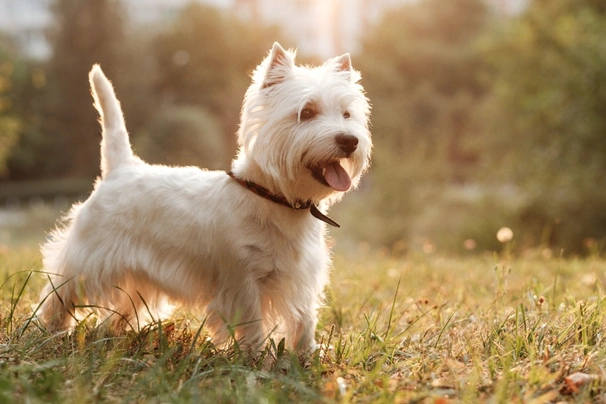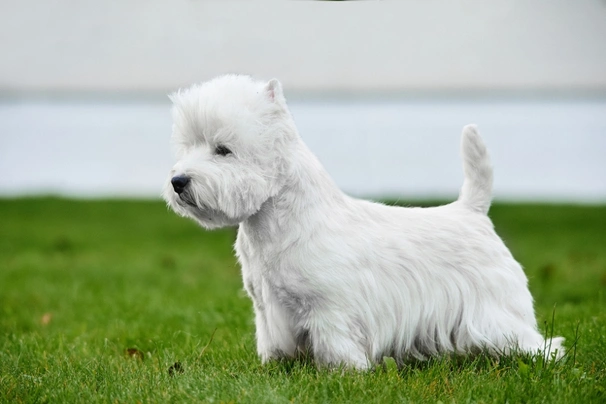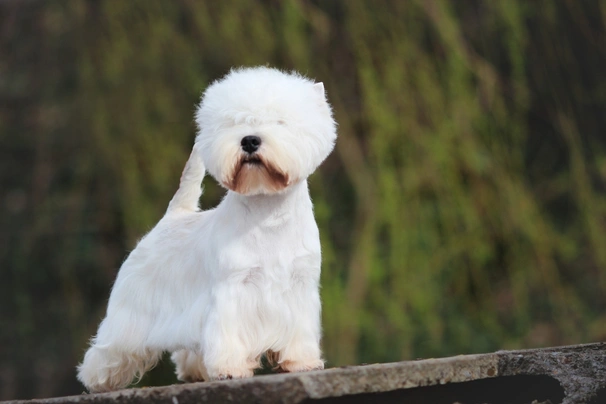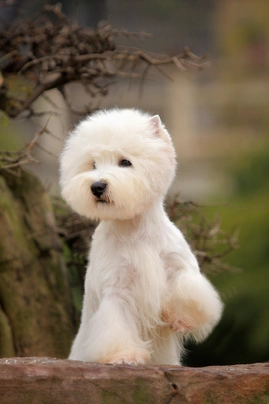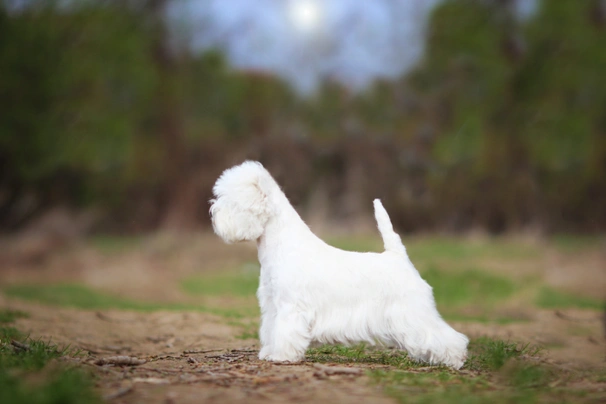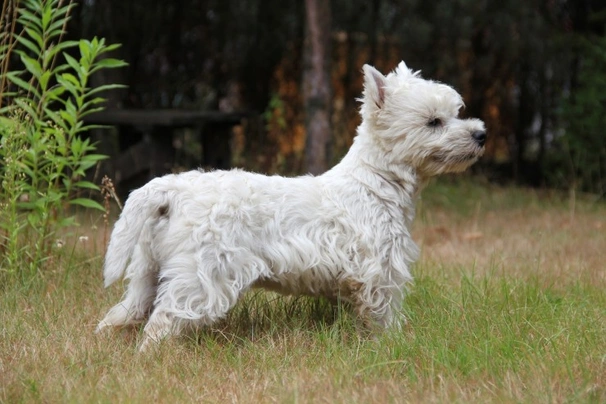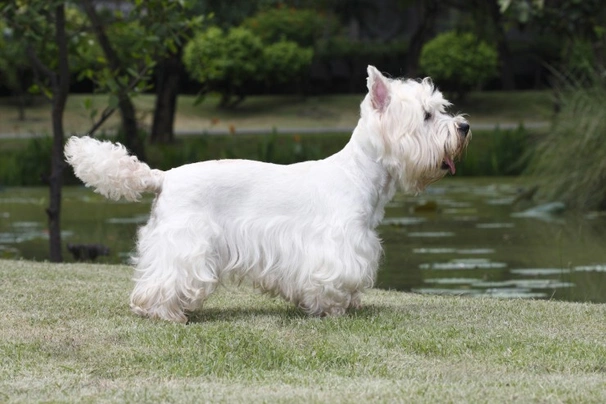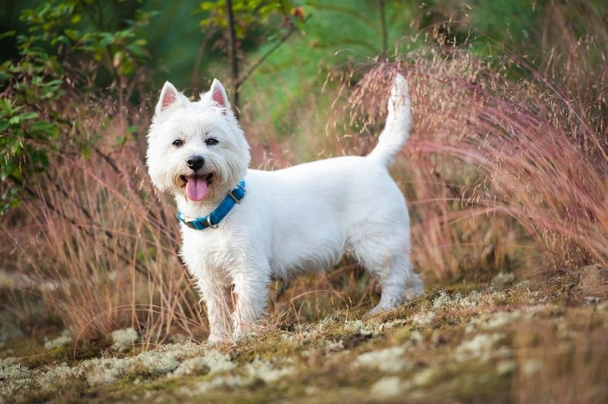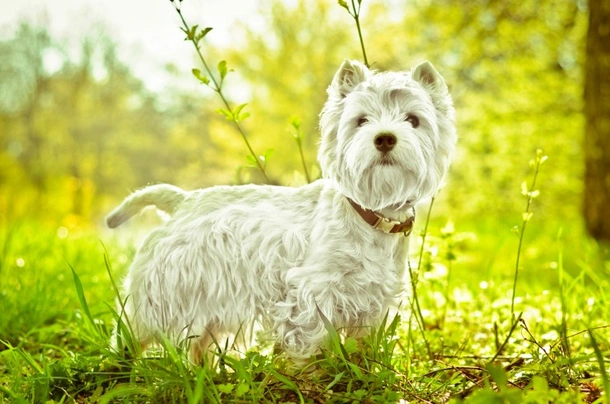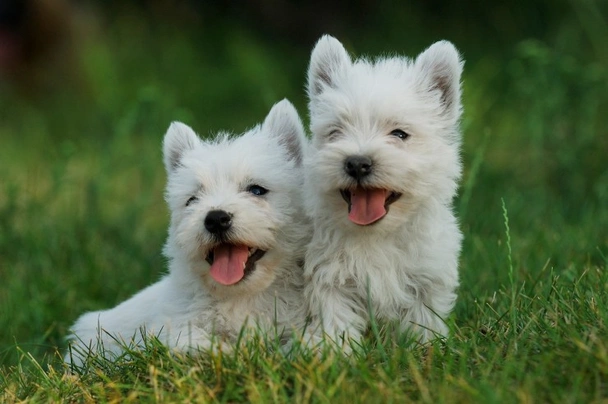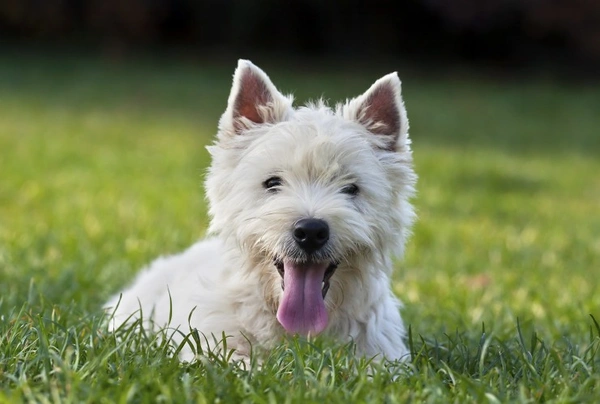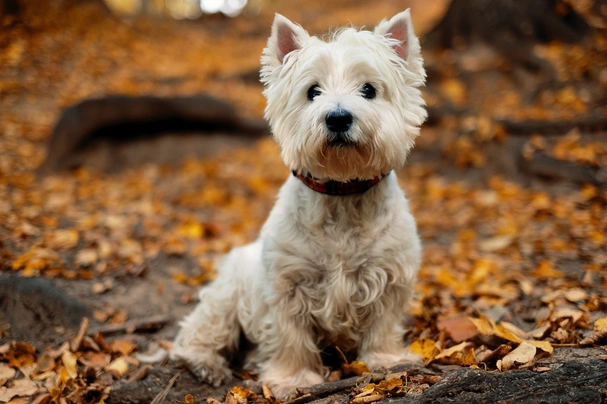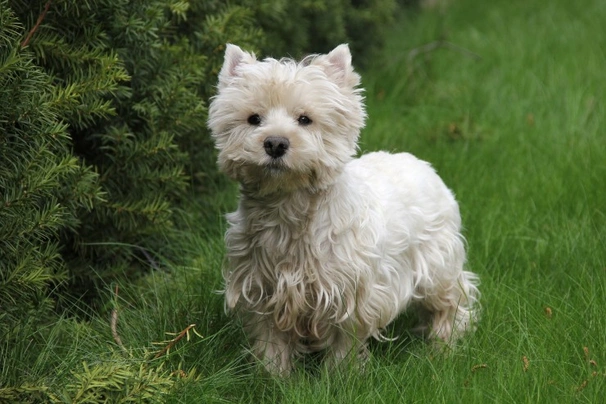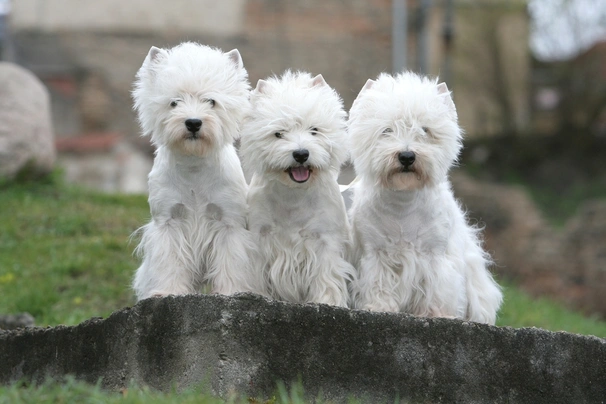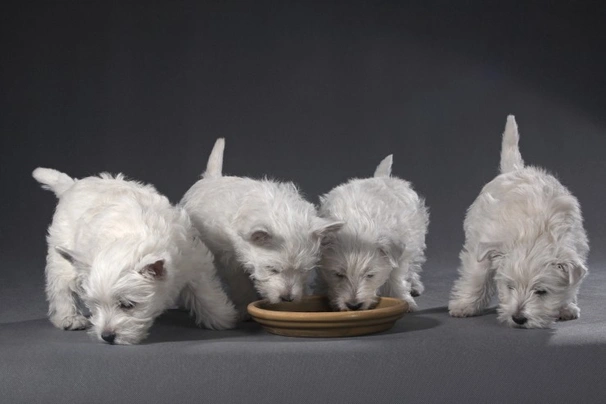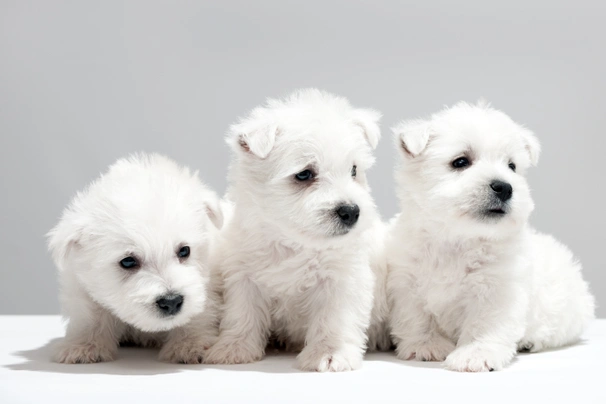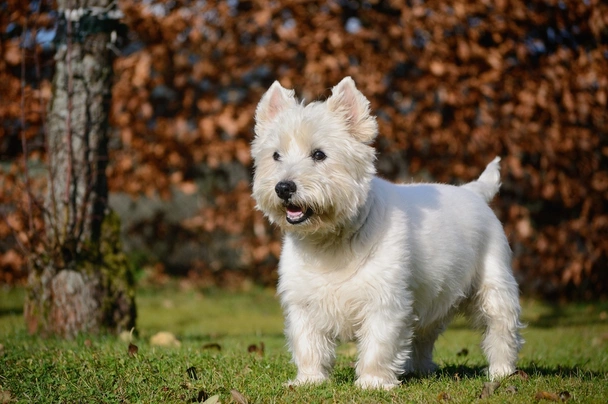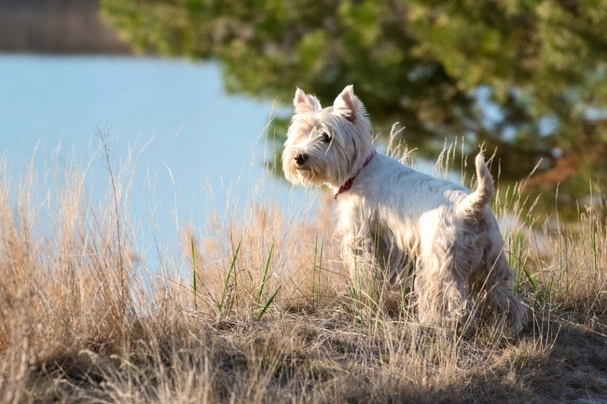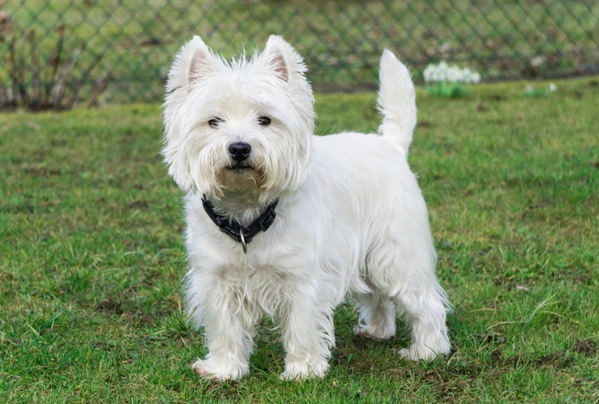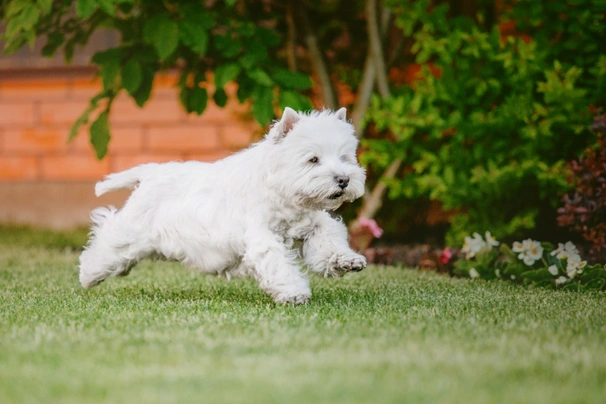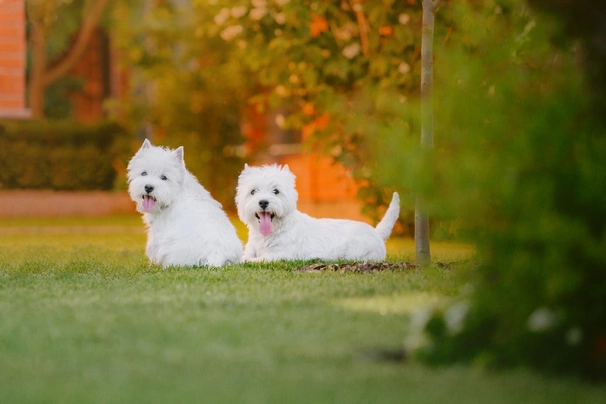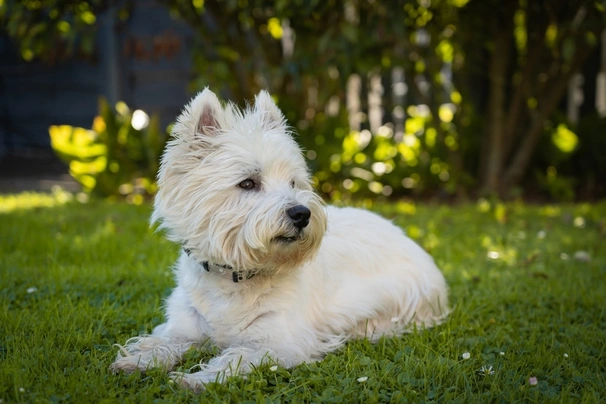West Highland Terrier
Pros
Cons
Introduction of the West Highland Terrier
The West Highland White Terrier, affectionately known as the Westie, is a breed that uniquely combines spirited energy with an unmistakably charming appearance. Beyond their iconic white coats, these terriers are renowned for their vivacious personalities, making them not only excellent family pets but also versatile companions suited to a variety of lifestyles. Once bred primarily for hunting small game and vermin, modern Westies now thrive as affectionate companions in urban flats and country homes alike, provided their need for mental and physical exercise is fulfilled.
Physically compact yet muscular, Westies possess a distinctive pure white double coat consisting of a harsh outer layer coupled with a soft, insulating undercoat. Their alert dark eyes, erect ears, and confident gait reflect their terrier heritage. Despite their small stature, they exhibit remarkable boldness, frequently engaging with dogs much larger than themselves, a trait that sometimes surprises new owners. Their temperament is lively, friendly, and intelligent, making them well-suited for active individuals, families, or retirees who can dedicate time to their care and exercise.
Perfect For
Active households that enjoy daily walks and outdoor activities will find the Westie an ideal companion. Their manageable size makes them adaptable to apartment living, provided mental stimulation and physical exercise needs are met. Owners willing to invest in regular grooming and socialisation will benefit from a highly affectionate, spirited dog that bonds deeply with its family.
Key Considerations
Prospective owners should be aware of the breed's grooming demands, including frequent brushing and professional trims to maintain the coat’s distinctive texture and prevent skin irritations. Their strong prey drive necessitates caution around smaller pets. Early, consistent socialisation is essential to curb unwanted dominant behaviours and excessive barking. Additionally, Westies are prone to separation anxiety if left alone for extended periods, requiring owners to plan appropriately to avoid behavioural issues.
History of the West Highland Terrier
The West Highland White Terrier's origins trace back to the rugged Highlands of Scotland as early as the 15th century, where they were selectively bred to hunt vermin, foxes, and otters. Sharing ancestry with other Scottish terriers such as the Dandie Dinmont, Cairn Terrier, and Scottish Terrier, the Westie was developed by breeding exclusively white puppies from litters, forming a unique lineage recognised for its signature coat colour.
Early Development
Historical accounts from the reign of James I reference "little white earth dogges" believed to be early ancestors of the Westie from Argyleshire kennels. The breed’s name is said to derive from Col Malcolm of Poltalloch, who mistakenly shot a brown terrier and thereafter bred exclusively white ones known as Poltalloch Terriers. During the 19th century, the Duke of Argyleshire bred similar white terriers on his Roseneath estate, leading to the Roseneath Terrier variant. By the late 1800s, white terriers were exhibited as White Scottish Terriers. The breed gained official Kennel Club recognition as the West Highland White Terrier in 1904, solidifying their status as a distinct breed focused on retaining their hardy work ethic and characteristic white coat for hunting visibility.
Modern Recognition
Today, the Westie enjoys international fame as a popular pet and show dog. They have remained one of the UK's beloved terrier breeds with well-established breed clubs maintaining strict standards for health, temperament, and appearance. Their versatility and charming nature have ensured a strong presence in both family homes and competitive dog events worldwide.
Appearance of the West Highland Terrier
Size and Build
The West Highland Terrier is a small, robust breed with both males and females standing between 25 and 28 cm tall at the withers. Weight ranges from 6.8 to 9.1 kg. They feature a compact, muscular body with a slightly domed skull, a defined stop, and a strong jaw lined with a correct scissor bite. Their sturdy, muscular neck transitions smoothly into well-angled shoulders, with short, powerful legs covered in thick, hard hair. The deep chest has well-arched ribs, while the broad, muscular hindquarters boast supple stifles and well-flexed hocks supporting agile movement. The larger front feet are padded with thick black nails, all covered in short hair. Their tail is straight, carried upright without feathering, complementing their energetic carriage.
Coat and Colours
Characteristic of the breed is a pure white double coat. The outer coat is harsh, straight, and approximately 5 cm in length, paired with a soft, dense undercoat providing insulation. The pure white coat is the only accepted colour by The Kennel Club, integral to the breed's identity and show standards. Coat texture influences grooming needs and suitability for hand-stripping, essential for maintaining the coat’s correct harshness and preventing softness.
Distinctive Features
The Westie’s head is slightly rounded with a defined stop and wide-set, medium-sized dark eyes that convey alertness and intelligence. Their small, erect ears possess sharp, well-defined tips and are covered in short, smooth hair. Movement is fluid and free, with front legs showing good reach from the shoulders and powerful hind legs demonstrating supple joint action, resulting in a purposeful gait.
Gender Differences
Size differences between males and females are minimal, though males tend to be slightly more robust. Temperamentally, females can be somewhat more independent, while males often display a more assertive character; however, personality varies individually. Breed standards require males to have both testicles fully descended for show eligibility.
Temperament of the West Highland Terrier
West Highland Terriers are celebrated for their lively, affectionate demeanour paired with a spirited terrier streak. These intelligent dogs are generally eager to please, making them good choices for first-time dog owners prepared for a lively pet with occasional stubbornness. Westies form strong bonds with their families, combining affectionate companionship with alert watchdog tendencies. Their confidence often belies their small size, leading them to engage boldly with larger dogs.
Core Personality Traits
While affectionate and playful, Westies can display classic terrier stubbornness, sometimes leading to selective deafness and independent decision-making. Their high prey drive means they retain strong hunting instincts, necessitating management when around small animals. Early, consistent training is essential to channel their energy positively.
Social Behavior
When socialised from a young age, Westies generally interact well with familiar people and canine companions. However, they can be wary or vocal around strangers, quickly alerting their owners to new arrivals. Their territorial instincts lead them to guard their home and family, which can result in excessive barking if not properly controlled.
Working Instincts
Having been bred as ratter dogs, Westies exhibit a pronounced prey drive, often expressed through digging and exploring behaviours. This working instinct requires ample outlets such as structured play and mental challenges to prevent boredom-related mischief.
Common Behavioral Challenges
Without adequate early socialisation and firm, consistent training, Westies may develop dominant or wilful behaviours, including stubbornness and excessive barking. Their attachment to owners can provoke separation anxiety, manifesting as destructive behaviour and persistent noise. Owners must provide sufficient exercise, mental enrichment, and structured routines to mitigate these tendencies effectively.
Intelligence / Trainability of the West Highland Terrier
Training a West Highland Terrier requires a blend of patience, consistency, and an understanding of their terrier temperament. Their intelligence and eagerness to please facilitate learning, yet their natural mischievousness and occasional stubbornness necessitate early and ongoing training. Positive reinforcement with treats, praise, and play works best, as harsh methods can discourage these sensitive dogs.
Puppy Training Priorities
Socialisation remains paramount during the critical first six months, with a focus on exposing puppies to varied environments, people, and animals post-vaccination to foster well-rounded adult dogs. Basic obedience commands, house training, bite inhibition, and setting clear boundaries help establish a strong foundation.
Training Methods That Work
Short, engaging training sessions tailored to maintain attention promote effective learning. Participation in puppy classes or obedience groups enhances social skills. Westies excel in canine sports such as agility and flyball, which also satisfy their working drives. Encouraging tracking and earthdog trials can provide mental and physical outlet suited to their heritage.
Advanced Training Potential
Adult Westies are capable of mastering complex commands and thriving in competitions. Their natural hunting instincts can be channelled positively, though owners must maintain clear leadership to prevent wilfulness or dominance.
Common Training Mistakes
Inconsistency, overdependence on treats, and harsh correction may hinder progress. Over-exercising puppies can damage developing joints. Awareness of breed-specific quirks and patience ensures a rewarding training journey for both dog and owner.
Children and other
West Highland Terriers generally make excellent companions for children, enjoying interactive play and offering spirited friendship. Their robust yet small size makes them suitable for families, though supervision is crucial to prevent overly boisterous play that might overwhelm the dog.
Age-Specific Interactions
Toddlers require gentle introductions with adults guiding appropriate touch and respect, especially around feeding or resting times. Older children benefit from energetic play and shared training sessions, fostering mutual respect and fun.
Teaching Children Proper Interaction
Children should be instructed on gentle handling, refraining from pulling ears or tails, speaking calmly, and recognising when to give the dog space, particularly when eating or sleeping. Clear behavioural boundaries help prevent stress and accidents.
Breed-Specific Considerations
The Westie’s strong prey drive means households with smaller pets should exercise vigilance. Despite cohabitation, their instinct to chase can prevail, underscoring the need for supervision. Their independent yet playful nature demands patient socialisation within a family context.
Creating Safe Environments
Designated safe zones for both dog and children, alongside secured play areas, ensure positive and safe interactions. Providing the Westie with a quiet retreat reduces stress and supports harmonious household dynamics.
Health of the West Highland Terrier
The West Highland White Terrier typically enjoys a lifespan ranging from 12 to 14 years, provided excellent care and routine veterinary management. As with many purebred dogs, they are predisposed to specific hereditary health conditions that responsible owners should monitor closely.
Breed-Specific Health Conditions
Common ailments include skin allergies like epidermic dysplasia, which require ongoing management to prevent irritation. Occasional deafness appears within the breed, and inherited metabolic liver disorders can influence longevity. Craniomandibular Osteopathy (CMO), a developmental jaw condition, is a significant concern tested via Laboklin. Lungworm infestations have become a growing issue in the UK, necessitating preventive measures.
Genetic Testing Requirements
Though The Kennel Club does not mandate compulsory testing, breeders are strongly encouraged to screen stud dogs for CMO and manage breeding practices sensibly to lower disease prevalence. Monitoring skin conditions and avoiding close inbreeding practices supports overall breed health.
Preventive Healthcare Schedule
Puppies should receive core vaccinations prior to sale, with follow-up shots at 10-12 weeks and veterinary-recommended boosters throughout life. Routine parasite control, dental care, and annual health checks are essential to maintaining wellness.
Insurance Considerations
Given their predisposition to skin and genetic issues, Westies often present higher-than-average vet claims. Owners are advised to obtain comprehensive pet insurance, preferably with lifetime coverage, to offset potential treatment costs and secure consistent care across life stages.
Caring for the West Highland Terrier
Maintaining a West Highland Terrier requires dedication to both coat health and overall wellbeing. Daily grooming to prevent matting and skin irritation counteracts the breed's allergy susceptibilities, complemented by structured exercise to manage their energetic character.
Daily Care Routine
A typical day includes two walks: a shorter morning stroll and a longer afternoon or evening session with interactive play, combined with brushing to manage shedding and promote healthy skin. Balanced meals tailored to age and activity support metabolism. Routine vet visits and parasite prevention complete comprehensive care.
Living Environment Needs
Westies adapt well across urban apartments to rural homes, provided secure garden access prevents escape attempts driven by their inquisitive nature. Fencing must be high and robust. Due to fair skin and coat, protection from sunburn especially on ears in summer is crucial, as is ensuring comfort during seasonal temperature extremes.
Seasonal Care Adjustments
In the summer months, sun protection with dog-safe sunscreen or lightweight coverings helps prevent sunburn. Winter care includes warm bedding and potentially supplementary shelter. Seasonal coat shedding peaks in spring and autumn, requiring increased grooming to manage discarded hair and maintain coat health.
Senior Care Adaptations
Older Westies benefit from softer, supportive bedding and adjusted exercise routines acknowledging possible arthritis or decreased stamina. Diet modifications to support joint health and weight maintenance, alongside safe, accessible environments, enhance senior quality of life.
Grooming of the West Highland Terrier
Grooming a West Highland Terrier demands commitment but rewards with a healthy coat and classic breed appearance. Their thick double coat requires daily brushing using tools such as slicker and soft bristle brushes to prevent mats and tangles, especially on legs and belly.
Coat Maintenance Schedule
Daily brushing is essential for removing dead hair and maintaining skin health. Professional grooming every 6 to 8 weeks is recommended, with hand-stripping preferred to preserve the harsh texture and the traditional "Chrysanthemum" head shaping seen in show circles.
Professional Grooming Requirements
Starting from about 16 weeks, professional grooming sessions gradually shape the coat across visits. Depending on coat texture, hand-stripping every 4 weeks is advised to maintain quality and comfort, which is essential for show-quality dogs.
Home Grooming Techniques
Owners should maintain routine tasks such as ear cleaning, nail clipping, and dental hygiene alongside brushing. Utilising appropriate grooming tools enhances ease and effectiveness.
Common Grooming Challenges
Mats can frequently appear on feathered areas if not brushed regularly, and persistent ear infections require prompt attention to avoid chronic issues. Moderate seasonal shedding peaks necessitate extra grooming in spring and autumn to reduce loose hair and allergen buildup.
Exercise of the West Highland Terrier
The West Highland Terrier is an energetic breed requiring a minimum of one hour of daily exercise, split ideally between a shorter morning walk and a longer more stimulating afternoon session. Their curious, active nature means they benefit from secure garden space allowing off-leash play, though fencing must be sturdy due to their escape tendencies.
Daily Exercise Requirements
Regular physical activity combined with mental stimulation through interactive play and varied walks helps prevent behavioural issues such as barking or digging linked to boredom. Exercise must be moderated during puppyhood to protect growing joints and adjusted according to weather conditions to ensure safety.
Suitable Activities
Westies enjoy participating in canine sports including agility and flyball as well as scent work and interactive games, which provide mental and physical enrichment. These activities exploit their natural working instincts and intelligence.
Exercise Restrictions
Young puppies should avoid vigorous or prolonged exercise to safeguard joint development. During extreme weather, activities should be reduced or modified to prevent heatstroke or cold-related health problems.
Mental Stimulation Ideas
Incorporating puzzle feeders, training sessions, and varied play routines encourage mental engagement, reducing the risk of mischief from boredom. Regular introduction of new challenges keeps Westies well-balanced and content.
Feeding of the West Highland Terrier
Proper nutrition is vital for the health and vitality of the West Highland Terrier throughout life stages. Their diet should be rich in quality protein and balanced fats to support energy levels and maintain skin and coat health, critical given the breed’s predisposition to allergies.
Nutritional Requirements
Puppies require nutrient-dense diets formulated for growth, while adult dogs benefit from maintenance diets matched to their activity level. High-quality commercial foods balanced for terrier breeds usually suffice.
Feeding Schedule Guidelines
Puppies thrive on three to four meals daily, gradually transitioning to two meals per day as they mature. Feeding should be portion-controlled to maintain an ideal weight and avoid obesity, with treat allowances kept low and consistent.
Special Dietary Considerations
Due to common allergy issues, some Westies need avoidance of certain proteins or grains. Supplements like omega-3 fatty acids may be beneficial for skin and coat health. Diet changes should be made gradually to prevent digestive upset.
Weight Management
Regular monitoring of body condition is essential to prevent overweight, which stresses joints and organs. Feeding controlled portions paired with daily exercise supports a healthy weight, enhancing lifespan and quality of life.
West Highland Terrier price
Purchasing a West Highland Terrier puppy from reputable, licensed breeders in the UK typically ranges between £1,400 and £2,000, while independent breeders may offer slightly lower prices from approximately £1,300 to £2,000. Factors influencing price include lineage, breeder reputation, and geographic location. Prospective owners can find West Highland Terrier puppies for sale on Pets4Homes.
Initial setup costs generally range from £150 to £300, covering essentials such as quality bedding, grooming supplies, appropriate diet, collars, leads, and toys. Regular professional grooming visits add to ongoing expenses, necessary approximately every 6 to 8 weeks.
Monthly maintenance costs including food, routine vet care, and insurance typically range between £50 and £80. Insurance premiums vary based on coverage options and location, averaging £20 to £45 per month. Veterinary costs cover vaccinations, neutering, parasite control, and unexpected treatments, all contributing to the annual budget.
Lifelong financial commitment should consider routine health screenings, grooming, supplements, insurance renewals, and potential treatment of breed-specific conditions, vital for sustaining quality of life.
Buying advice
The West Highland Terrier’s popularity means buyers must be vigilant against scams and unethical breeders. Prices for well-bred puppies range from £1,300 to £2,000 depending on breeder type and lineage. Prospective owners should always meet breeders personally and avoid purchases without direct inspection. For a reliable selection, find West Highland Terrier puppies for sale safely on Pets4Homes.
Finding Ethical Breeders
Ethical breeders adhere to The Kennel Club guidelines, conducting health screens, managing breeding frequency responsibly, and socialising puppies adequately. Visits to breeder premises and reviewing health paperwork for the dam and puppies are essential steps.
Health Testing Verification
Buyers should confirm testing for Craniomandibular Osteopathy (CMO) via Laboklin and review vaccination and microchip records. Ensuring coat quality and temperament meet breed expectations reduces potential future issues.
Puppy Selection Process
Evaluating litter temperament and individual puppy behaviour aids in selecting a well-adjusted companion. Physical health checks and alertness are important markers of puppy condition.
Contract and Guarantee Review
A clear contract including health guarantees and purchase terms protects buyers. Beware of breeders reluctant to provide documentation or requesting deposits without in-person visits.
Rescue and Adoption Options
Breed-specific rescues for Westies facilitate rehoming, offering an alternative to buying. Adopting a rehomed Westie can be fulfilling, with many rescues providing support throughout the transition.
